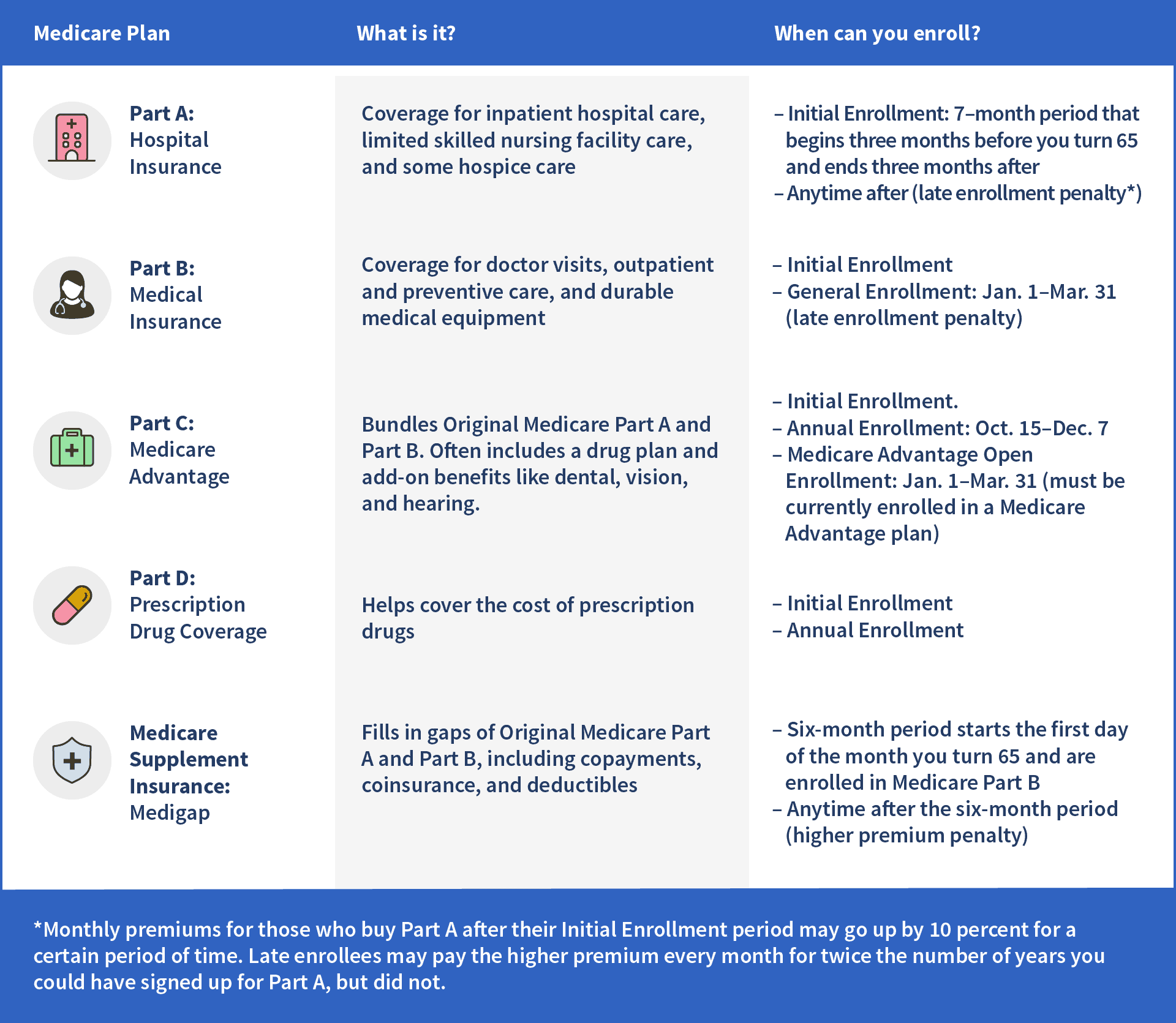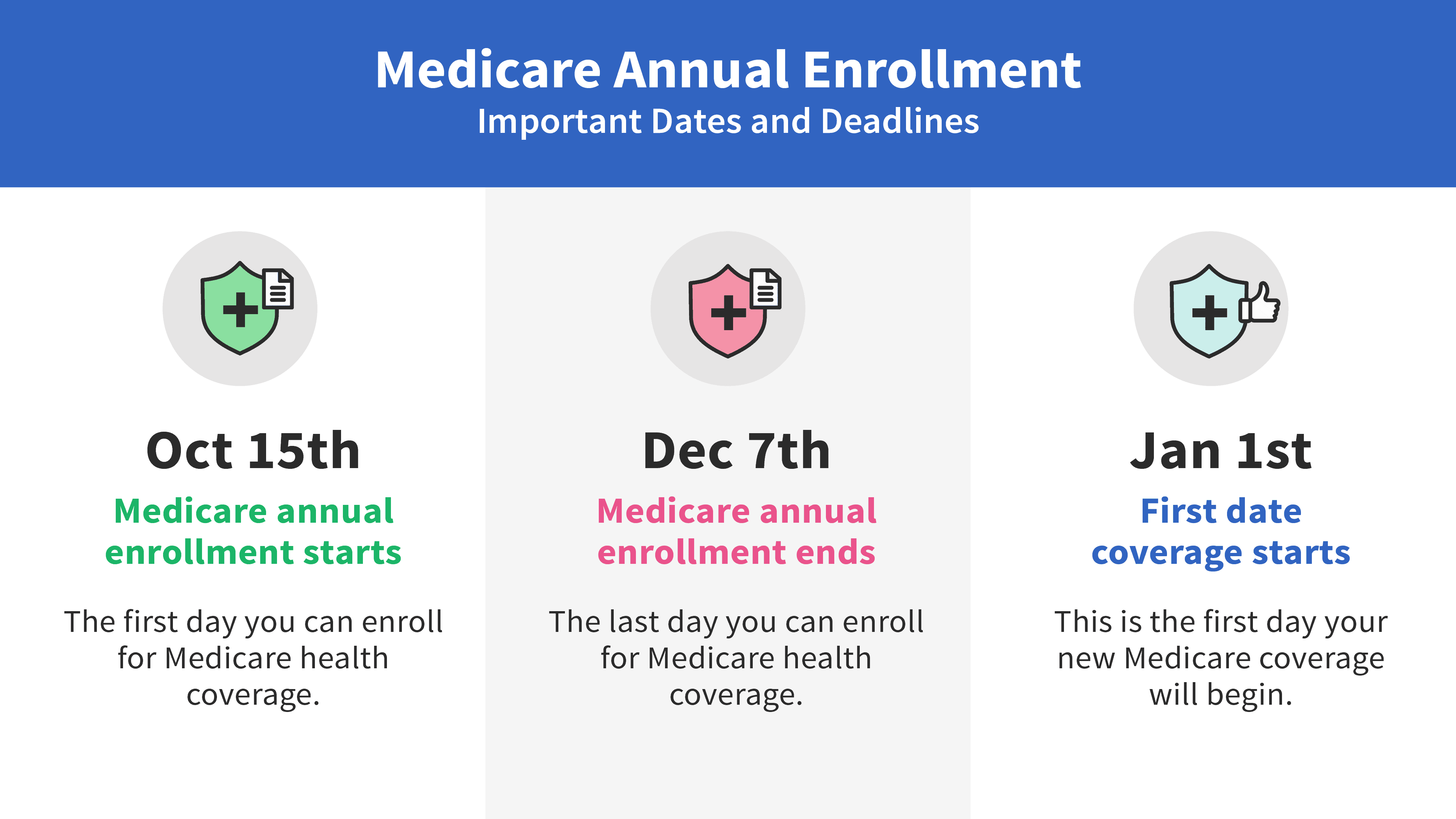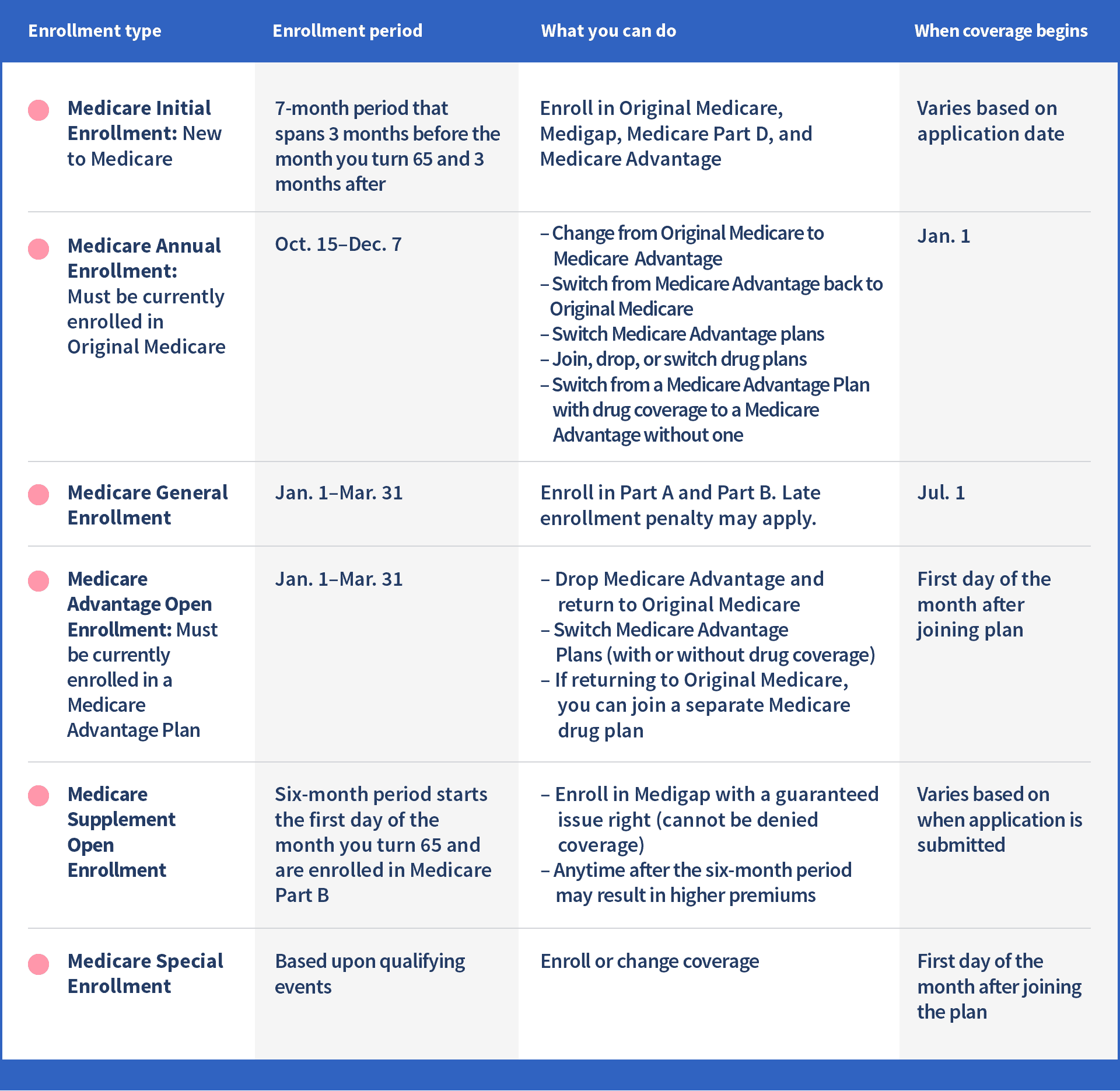Eligible for Medicare this Year? Here's Everything You Need to Know
Equipped with the right information and resources, you can ensure that you sign up for the best Medicare coverage for your needs during enrollment.
SeniorLiving.org is supported by commissions from providers listed on our site. Read our Editorial Guidelines
If you’re overwhelmed about Medicare’s annual enrollment process, you’re certainly not alone! In this article, we’ll guide you through what Medicare covers, eligibility, costs, how and when to enroll step by step, and frequently asked questions about enrollment. We’ll also go through the details of supplemental insurance to help ease out-of-pocket expenses.
Table of Contents
- What Is Medicare Insurance?
- Who Is Eligible for Medicare?
- What Does Medicare Cover?
- What Does Original Medicare Not Cover?
- How Does the Medicare Deductible and Coinsurance Work?
- How to Enroll in Medicare
- Additional Insurance Options
- Medicare Late Penalties
- Frequently Asked Questions About Medicare
- Medicare and Medigap Learning Center
What Is Medicare Insurance?
Think of Medicare insurance like a crossword puzzle. Many pieces go into the Medicare puzzle to make it complete. We all know crossword puzzles can be frustrating, so let’s dive into what makes up Medicare insurance.
The Centers for Medicare & Medicaid Services (CMS) is the agency in charge of the Medicare program. However, Social Security processes your application for Original Medicare (Part A and Part B).2
Original Medicare is a federal insurance program with two parts:
- Medicare Part A, also known as hospital insurance
- Medicare Part B, also known as medical insurance
While Original Medicare through the government is a great starting point, it won’t cover everything. Additionally, Original Medicare doesn’t have a limit for out-of-pocket costs, which means your cost-sharing responsibility can accumulate without a cap. Medicare also contracts with private insurance companies to offer additional coverage:
- Medicare Supplement Insurance, also known as Medigap
- Medicare Advantage plan, also known as Medicare Part C
- Medicare Part D, also known as Prescription Drug Plans (PDPs)
We’ll take a closer look at all of these options later in this article.
The table below breaks down the different parts of Medicare, what they cover, and when you can enroll. We’ll also take a closer look at all of these options later in this article.
Watch our “Introduction to Medicare” video below. You’ll be a Medicare expert in no time!

Who Is Eligible for Medicare?
To be eligible for Medicare Part A and Part B, you must meet at least one of the following criteria:
- You are 65 or older.
- You have been disabled for at least 24 months.
- You have end-stage renal disease (permanent kidney failure requiring dialysis or transplant).
- You have ALS (also known as Lou Gehrig’s disease).
If you’re under the age of 65, you may still qualify for Medicare Part A and Part B as long as you receive Social Security Disability Insurance (SSDI) because you have Lou Gehrig’s disease, have been on SSDI benefits for 24 months, receive disability pension from the Railroad Retirement Board, or have other approved conditions.
Pro Tip: Find out if you’re eligible for Medicare and what your estimated monthly premium will be by visiting the Medicare.gov eligibility calculator.
What Does Medicare Cover?
With Original Medicare, you can go to any doctor or hospital in the U.S. that takes Medicare. Below, we’ll look at what Original Medicare (Parts A and B) covers.3
Medicare Part A (hospital insurance) helps cover:
- Inpatient hospital care
- Medication as part of your inpatient treatment
- Semiprivate room
- Meals during your hospital stay
- Other inpatient hospital services and supplies
- Short-term care at a skilled nursing facility (following a hospital stay)
- Hospice care
- Some home health care
Medicare Part B (medical insurance) helps cover:
- Preventative services, including annual wellness visits, screenings, and vaccines
- Outpatient care, including physical, speech, and occupational therapy
- Durable medical equipment, including wheelchairs, walkers, and hospital beds
- Services from doctors and other health care providers
What Does Original Medicare Not Cover?
Remember, Medicare Part A and Part B covers some hospital and medical expenses, not all. If you need a service that Part A or Part B doesn’t cover, you’ll have to pay out of pocket. Don’t panic — there may be other options to fill these potentially costly gaps.
These are some of the major items and services that Original Medicare doesn’t cover:4
- Long-term care, including nursing home or assisted living care
- Most dental care, including dentures
- Hearing aids and exams for fitting them
- Eye exams for prescription glasses
- Routine podiatry care
- Cosmetic surgery
- Massage therapy
- Services or covered treatment you get from an opt-out doctor or other provider
- Medical care outside of the U.S.
- Concierge care, also referred to as retainer-based medicine, concierge medicine, or direct care
- Most prescription drugs
Let’s face it. Researching and understanding the ins and outs of Medicare can be complicated. There are several important things you need to know before you enroll to ensure that you receive the coverage you need. Watch the video with our Editor-in-Chief, Jeff Hoyt, as he covers things you might not know about Medicare that could hurt you.

How Does the Medicare Deductible and Coinsurance Work?
Medicare Part A and Part B come with several cost-sharing expenses. It’s important for Original Medicare enrollees to know there is no yearly limit for out-of-pocket expenses.5 Unless you have additional coverage, such as a Medigap plan, you may face extensive health care costs, depending on your needs. The chart below looks at the major out-of-pocket expenses with Original Medicare.
| Plan | Expense type | Out-of-pocket cost |
|---|---|---|
| Medicare Part A | Inpatient hospital deductible | The 2024 Medicare Part A annual deductible is $1,632 for the first 60 days of Medicare-covered inpatient hospital care. |
| Medicare Part A | Coinsurance | Should your inpatient hospital care continue past 60 days, you'll be responsible for daily coinsurance based on the duration of your hospital stay. |
| Medicare Part B | Monthly premium | The standard Medicare Part B premium for 2024 is $174.70. |
| Medicare Part B | Annual deductible | The annual deductible for Part B beneficiaries for 2024 is $240. |
| Medicare Part B | Coinsurance | Part B enrollees pay 20 percent of the Medicare-approved amount for all Part B services. |
Did You Know? If your modified adjusted gross income as reported on your IRS tax return from two years ago is above a certain amount, you may pay the standard Part B and Part D premium plus an income-related monthly adjustment amount.6
How to Enroll in Medicare
Unsure when you can sign up for a Medicare health or drug plan? With so many older adults and other Medicare beneficiaries living on a fixed income or surviving solely on Social Security, the last thing you want is to face late enrollment penalties.
Important Enrollment Dates to Remember
Avoid unnecessary late enrollment fees by signing up for Medicare during the proper enrollment periods.
- During your initial enrollment period: Your initial Medicare enrollment period lasts for seven months, starting three months before you turn 65 and ending three months after the month you turn 65.7
- During the Medicare annual enrollment period: At any time during annual enrollment, you can join, drop, or switch to another plan. This includes Medicare Advantage and Medicare Part D drug plans. Open enrollment for Medicare is from Oct. 15 to Dec. 7.
- During the Medicare Advantage open enrollment period: This is only for individuals who already have a Medicare Advantage plan. During this time, you can switch to another Medicare Advantage Plan or drop your Medicare Advantage Plan and return to Original Medicare. Open enrollment is from Jan. 1 to March 31.
- During the Medigap open enrollment period: Medigap’s six-month open enrollment starts the first day of the month you’re 65 or older and enrolled in Medicare Part B.
- During Medicare’s special enrollment period: Certain circumstances allow you to enroll in Medicare without paying a costly late enrollment penalty. For example, there is an eight-month period for Medicare special enrollment if your group health plan coverage (or the current employment it is based on) ends.8
Medicare plan pricing, coverage, and provider networks can change every year. This is why it’s so important to review your Medicare selections every year. Never set it and forget it!
A Step-by-Step Guide on How to Enroll in Medicare
If you’re a Medicare newbie, our Medicare step-by-step guide will walk you through how to sign up for Medicare online or over the phone with the Social Security Administration (SSA).
How to Sign Up for Medicare Online
- Gather all of the information you’ll need to complete your online application. Use the application checklist provided by the SSA to prepare for the application process.
- Create a my Social Security account. Our step-by-step my Social Security guide walks you through how to set up your account.
- Apply for your benefits. Go to the SSA’s page to apply for benefits. You’ll need your my Social Security account login to get started.
- Select the “start a new application” button. The online application process may take 10 to 30 minutes, depending on your situation.
- Check your application status. Once you have completed and submitted your Medicare application, you can check the status of your enrollment at any time. Simply sign in to your my Social Security account.
- Look out for your mail carrier. Once your Medicare application is complete, your Medicare card will be mailed along with a Medicare welcome packet. Need your Medicare card right away? It’s as easy as logging in to your my Social Security account and printing your official card.
Did You Know? Enrolling in your Medicare benefits online allows you to complete the application at your own pace from the comfort of your home. Need to take a break? You can save your online application and come back to it.
How to Sign Up for Medicare by Phone
- Contact the SSA. Call the SSA toll-free at 800-772-1213. If you are deaf or have hearing loss, call the toll-free TTY number, 800-325-0778.
- Call during customer service hours. Representatives are available Monday through Friday from 7 a.m. to 7 p.m.
Additional Insurance Options
It may come as a shock to learn that Original Medicare doesn’t cover some of the health-related needs of older adults and other Medicare beneficiaries. The good news is that Original Medicare isn’t your only option for health care coverage! You have the power to choose additional private insurance coverage tailored to your needs and budget.
Medicare Supplement Insurance, Medicare Advantage, and Medicare Part D plans are available from private companies that contract with Medicare.
Medicare Supplement Insurance
Medicare Supplement Insurance policies, also known as Medigap, help fill the gaps for Original Medicare’s out-of-pocket expenses such as copayments, deductibles, and coinsurance. As you shop for Medigap plans, know that the insurance companies must offer the same benefits for each plan. For example, Medigap Plan A through Aetna will be identical to Plan A through UnitedHealthcare.
The six-month Medigap open enrollment begins the month you turn 65. Adults under the age of 65 with end-stage renal disease or a disability may be eligible for Medigap plans.
During open enrollment, insurance companies cannot deny you based on preexisting conditions or charge you more because of them.
Medicare Advantage (Part C)
Just like Medigap, Medicare Advantage is offered through private insurance companies. Medicare Advantage, also known as Medicare Part C, includes Medicare parts Part A, Part B, and often Part D (a prescription drug plan). Some Medicare Advantage plans offer extra benefits, like vision, hearing, and dental.
Keep in mind that Medicare Advantage and Medigap plans are not the same. Unsure which private insurance plan is right for you? Our research team details the pros and cons of Medicare Advantage and Medigap to help you make an informed decision.
Medicare Part D
As you prepare for Medicare enrollment, it’s important to think about your prescription medications and how you’ll pay for them. Prescription drugs are not covered under Original Medicare, and the out-of-pocket costs can quickly add up.
Every Medicare enrollee gets the opportunity to enroll in a separate Medicare Prescription Drug Plan (PDP). SeniorLiving.org’s top picks for Medicare Part D plans is a fantastic starting point to explore!
As we age, prescription drugs may be filling our medicine cabinets. Jeff Hoyt, our editor-in-chief, explains several ways to save on prescription drugs, including State Pharmaceutical Assistance Programs (SPAPs) and Patient Assistance Programs (PAPs) below.

Dental
Medicare rarely pays for dental services. Medicare Part A may pay for certain dental services that you get in a hospital if you need emergency or complicated dental procedures.9
Did You Know? Some dental plans require a waiting period before covering major dental work such as crowns or bridges. Our team researched dental plans and provided SeniorLiving.org’s favorite picks for Medicare dental supplement plans to help you find the right one for your needs.
The rest of your dental care — such as cleanings, dentures, dental plates, and tooth extractions — comes out of your pocket. Many Medicare Part A and Part B enrollees opt for a private dental plan to lessen these expenses. Additioanlly, some Medicare Advantage plans offer extra dental benefits. Be sure to consider dental benefits when looking for a Medicare Advantage plan.
Vision Insurance
We need to take care of our eyes as we age. Older adults and other Medicare beneficiaries may face glaucoma, age-related macular degeneration, and cataracts. Adding a vision insurance plan to your Medicare coverage can lessen the worry about unexpected expenses. Head to our guide to the best vision insurance for seniors for a breakdown of our recommendations for vision plans for older adults.
Medicare Late Enrollment Penalties
Just say no to procrastination when it comes to enrolling in Medicare and supplement insurance! According to Medicare.gov, if you miss open enrollment, you may pay the following late enrollment penalties or, in the worst-case scenario, be denied coverage.
- Medicare Part A and Part B: If you don’t enroll in Part A and Part B during your initial enrollment period, you may have to wait to sign up. This may cause a gap in your coverage, and you may have to pay a lifetime late enrollment penalty — and that late enrollment penalty gets bigger the longer you wait.
- Medicare Part D Prescription Drug Plans: If you don’t join a PDP when you first get Medicare, you may pay a late enrollement penalty for as long as you have Medicare drug coverage if you join later.
- Medigap plans: If you delay enrolling in a Medigap policy when you’re first eligible, you may not be able to buy one later, or you may pay more.
Frequently Asked Questions About Medicare
What are the different parts of Medicare?
There are two federally run parts of Original Medicare: Medicare Part A (hospital insurance) and Medicare Part B (medical insurance). In addition to Part A and Part B, Medicare contracts with private insurance companies to offer Part C (Medicare Advantage) and Part D (Prescription Drug Plan).
Who is eligible for Medicare Part B?
Any individual who is eligible for Medicare Part A is also eligible for Medicare Part B. Keep in mind that while Medicare Part A is free for most individuals, Medicare Part B has a monthly premium.
Should I enroll in Medicare Part B if I have VA benefits?
Yes, even if you have VA benefits, you should enroll in Part A and Part B when you turn 65. The U.S. Department of Veterans Affairs does not recommend that veterans cancel or decline coverage in Medicare (or other health care or insurance programs) solely because they are enrolled in VA health care.
From the experts: Learn more about the wide range of VA benefits available to qualifying veterans in our veteran care guide.
What if I can’t afford my Medicare costs?
Several state-run Medicare Savings Programs are available to low-income Medicare beneficiaries struggling to pay premiums, deductibles, and copays. Head over to our Medicare Saving Programs guide to learn more.
How do I pay my Medicare bill?
If you’re receiving Social Security benefits, it's likely that your Medicare costs will automatically be deducted from your Social Security check. If you’re not receiving benefits yet, you’ll get a bill for your Medicare premiums in the mail.
There are four ways to pay your monthly premium. You can pay through …
- Your Medicare account. Log on to your secure Medicare.gov personal account, or create one if this is your first time paying your bill. There is no charge to pay your Medicare premium online.
- Online bill pay. If your financial institution offers online bill pay service, schedule your Medicare payment through your bank’s bill pay. Some banks charge an online bill pay fee, so be sure to ask beforehand.
- Medicare Easy Pay. Medicare Easy Pay is a free service through Medicare that automatically deducts your premium payments from your savings or checking account each month.
- Mail. If you prefer to mail in your payment, Medicare accepts payment in the form of check, money order, or credit or debit card.
Don’t forget: Your Medicare bill usually arrives around the 10th of each month. Your Medicare premium bill is due by the 25th of each month.
What is the difference between Medicare and Social Security?
Both of these federal programs are in place to support the needs of adults age 65 or over and individuals with disabilities. However, the two programs support different needs. Medicare’s role is to provide health insurance. Social Security’s role is to provide financial support based on factors such as your earnings and work history.
Medicare and Medigap Learning Center
Medicare Resources
Have you reached information overload? From costs and coverage to deductibles and late enrollment penalties, it’s easy to fall down the Medicare rabbit hole! Explore these Medicare resources to make sure you understand all that Medicare has to offer (and its limitations).
- What you need to know about Medicare Part B
- What you need to know about Medicare Part C
- Does Medicare cover assisted living care?
- Does Medicare cover skilled nursing care?
- Does Medicare cover nursing home care?
- Does Medicare cover hospice?
- Does Medicare cover in-home care?
- Does Medicare cover memory care?
- Does Medicare cover respite care?
- Does Medicare cover medical alert systems?
- Does Medicare cover hearing aids?
- Medicare and Medicaid health insurance
- 2025 Social Security, Medicare, and retirement changes seniors need to know about
- Medicare Coverage Helplines
Medigap Resources
With 10 Medigap plans to choose from (eight if you became eligible for Medicare after Jan. 1, 2020), it’s important to understand what each plan covers. This is especially crucial if you have ongoing health challenges. Our research team has put together SeniorLiving.org’s recommendations for Medigap to help you along your journey.
- Best Medigap plans
- Medicaid Planning: What Seniors Need to Know
- Best Medigap plans for healthy seniors
- Best Medigap plans for low-income seniors
- Best Medigap plans for seniors with cancer
- Best Medigap plans for seniors with diabetes
Medigap Insurance Reviews
The plethora of insurance companies offering Medicare Supplemental Insurance plans can make your head spin! Explore our in-depth reviews to find out the pros and cons of each carrier.
- Aetna Medigap plans review
- Blue Cross Blue Shield Medigap plans review
- Cigna Medigap plans review
- Colonial Penn Medigap plans review
- Humana Medigap plans review
- Mutual of Omaha Medigap plans review
- UnitedHealthcare Medigap plans review
Medicare Advantage Reviews
If you think that Medicare Part C plans might be right for you, explore our in-depth reviews of each carrier.
- Humana Medicare Advantage Plans Review
- Anthem Medicare Advantage Plans Review
- Aetna Medicare Advantage Plans Review
- AARP Medicare Advantage Plans Review
- Wellcare Medicare Advantage Plans Review
- UnitedHealthCare’s Medicare Advantage Plans Review
- Kaiser’s Medicare Advantage Plans Review
- Blue Cross Blue Shield Medicare Advantage Plans Review
- Cigna Medicare Advantage Plans Review
- CareFirst Medicare Advantage Plans Review
- DevotedHealth Medicare Advantage Plans Review
U.S. Centers for Medicare & Medicaid Services. (2021). CMS Releases Latest Enrollment Figures for Medicare, Medicaid, and Children’s Health Insurance Program (CHIP)
.Social Security Administration. (2021). Medicare.
Medicare.gov. (2021). Inpatient hospital care.
Medicare.gov. (2021). What's not covered by Part A & Part B?
Medicare.gov. (2021). Compare Original Medicare & Medicare Advantage.
Medicare.gov. (2021). 2021 Medicare Costs.
Medicare.gov. (2021). When does Medicare coverage start?
Social Security Administration. (2021). Special Enrollment Period (SEP).
Medicare.gov. (2021). Dental services.



